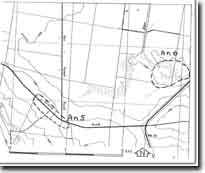An6 - Balliang Creek - Dryland Salting
|
This information has been developed from this publication:
|
| Location: | Anakie - 685036. Shire of Corio. West of Bacchus Marsh - Geelong road 9 km northeast of Anakie. | |
Access: | Bacchus Marsh - Geelong road. | |
Ownership: | Private land. | |
Site Description: | The site includes a sector of a small unnamed tributary of Little River which has been considerably affected by dryland salting. The stream occupies a shallow valley north of a low granite ridge and flows across granitic sands and weathered basalt in a channel which has been in part artificially straightened and deepened. The salted land lies adjacent to the channel and consists of unvegetated elongated pans with an encrustion of salt and mud. The salting has been noticed for over 50 years and the salt affected area has steadily increased in size. It appears to be a result of a rise in a saline body of groundwater residing in a basalt aquifer; this rise occasioned by a reduction in the transpiration rate due to extensive clearing of tree vegetation in the groundwater catchment that feeds the stream. | |
Significance: | Regional. The salting is typical of the response of many soils in moderate to low rainfall areas of Victoria which have experienced a rise in the saline water table following extensive deforestation. This is the most extreme case of dryland salting noted in the study area. | |
Management: | Class 3. Intensive research has been carried out in Victoria in recent years into the nature and causes of dryland salting. No simple short-term solution is as yet available to arrest the spread of salting in these conditions. | |
References: | Dyring J (1980) | |



